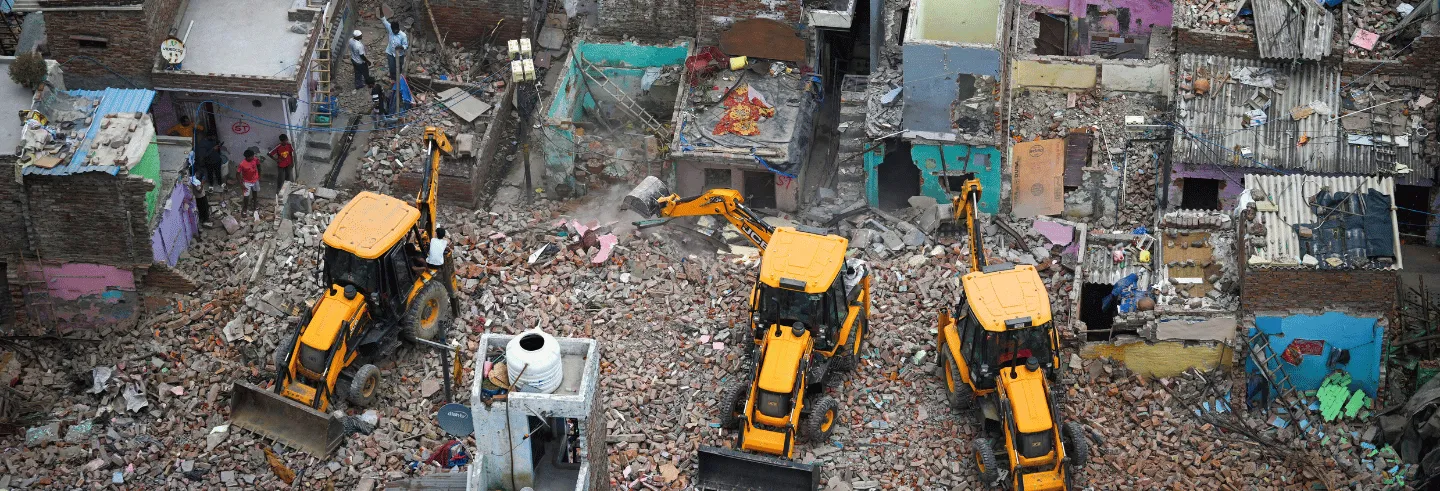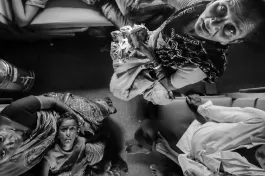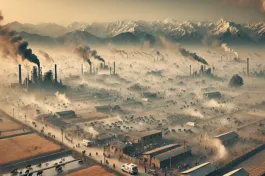On the morning of 4 October, bulldozers rolled into the Zakhira and Sailani areas of Bareilly, demolishing a range of buildings including shops, a marriage hall, and some residential houses.
The Bareilly Development Authority alleged that these structures had been constructed illegally. But the bulldozer action came hot on the heels of a series of clashes for which Muslim community leaders were blamed. It is their properties that faced the wrath of the bulldozers.
As demolitions such as the one Bareilly witnessed have become common place, the giant yellow bulldozers manufactured by the British firm JCB have rapidly emerged as a symbol of destruction for millions. Politicians compete to appropriate the sheer force of these machines to buttress their hardline image through demolitions of informal settlements and properties of those accused of crime.
For vulnerable communities though, such is the overwhelming destructive presence of the bulldozer that they have started identifying governments as a ‘Bulldozer Raj’: a regime that promised housing for all, but instead sent bulldozers to destroy homes without providing any decent alternative accommodation.
The transformation of a tool of construction into symbol of destruction is metaphorical of India’s urban growth story. Post-colonial India is no stranger to development induced displacement. Between 1947 and 1997 in India, approximately 50 million people experienced displacement due to developmental projects, with large dams alone causing the dispossession of 16 million people (Baviskar 2019).
Demolitions have become a site of this ‘otherisation’ of Muslims, leading to a self-perpetuating cycle of labelling, pushback, and further labelling.
Until recently, such development-induced displacement was primarily a rural phenomenon. Resistance from social movements led by affected communities and their allies eventually led the United Progressive Alliance (UPA) government to enact legislations to check this phenomenon, resulting in the Forest Rights’ Act (2008), and the Right to Fair Compensation and Transparency in Land Acquisition, Rehabilitation and Resettlement Act (2013).
With increasing urbanisation, sharp conflicts over land have emerged in towns, cities and peri-urban areas. The last few years have witnessed major demolition and eviction drives in urban centres such as Delhi, Mumbai, Ahmedabad, Prayagraj, Lucknow, Haldwani, Khargone, Ajmer, Jaipur, Surat and many others. While such drives have been a part of urban development in the past, the recent wave is strongly intertwined with the logic of majoritarian, authoritarian and corporate governance (Pati 2025).
A close inspection of the Bulldozer Raj suggests that it operates on the basis of a threefold logic: of clearing encroachments, of pushing back illegal immigrants, and of dispensing justice.
Encroachment clearance is a long-term facet of urban planning, but it is increasingly riddled with administrative violence and blatant disregard for established policies and legal precedents, and it is being used as a political weapon to target working classes and minorities. Its patterns indicate powerful control by corporations on policy making and governance. This is accompanied by a dehumanising public discourse against the migrant working class who form the majority of the ‘encroachers’. This anti-worker discourse intersects with the anti-immigrant discourse increasingly directed against India’s Muslims and Bengali-speaking citizens.
----------------------------------------------------------------------------
Also read: Bulldozing Justice, One Bent Rule at a Time
----------------------------------------------------------------------------
The third logic—of dispensing justice – implies the demolition of properties of (predominantly Muslim) dissenters and criminal suspects as a punitive measure, sometimes on the basis of mere suspicion. It continues despite being outlawed by the Supreme Court in 2024. Hindutva content creators have triumphantly labelled this as ‘bulldozer justice’ and christened its chief practitioner—the Uttar Pradesh Chief Minister Yogi Adityanath—as the ‘Bulldozer Baba’. Adityanath wears this crown with elan. Hindutva rappers sing paeans to his acts of destruction through ‘bulldozer rap’.
From Construction to Destruction
Ahead of the 2014 Lok Sabha elections, the Bhartiya Janata Party (BJP) made ‘urban upliftment’ one of its poll planks. The party’s election manifesto promised to build 100 new technology-enabled sustainable cities and to upgrade existing urban centres. Provision of sufficient housing, efficient waste and water management, reliable public transportation, and urban poverty alleviation were identified as thrust areas. Yet, when the BJP sought a repeat term, the party's 2019 manifesto did not have a separate section on urban development. The 2024 manifesto vaguely reiterated most of the 2014 promises without listing any achievements of the government in this regard.
The reality is completely hidden by the ‘encroachment’ discourse which demonises the working classes but does not say a word about hotels, farmhouses, or unauthorised parking by the rich on public land.
On the ground, the promised schemes lost their way. The Smart Cities Mission shuttered in March 2025 without any clear statement from the government as to how far its goals had been achieved. The Pradhan Mantri Awas Yojana – Urban (PMAY-U) fell far short of its objectives. An overwhelming majority of the homes (about 83%) constructed under the PMAY-U by May 2024 were for families that had access to capital or land. The slum rehabilitation scheme within PMAY-U had sanctioned only 2.96 lakh homes by May 2024, around 20% of the estimated demand and constituting just about 2.5% of the total beneficiaries of PMAY-U.
The gradual backtracking went hand in hand with the spectacle of destruction.
Among megacities, Delhi was easily the worst affected. Demolitions of informal settlements picked up pace in the months leading up to the G20 summit in 2023, and continued thereafter. As reported by the Housing and Land Rights’ Network (HLRN), in 2023 alone, there were 5 lakh forced evictions throughout the country, out of which Delhi accounted for 2.8 lakhs.
After the BJP took power in the state earlier in 2025, the destruction has accelerated. In the first four months of the new government, nearly 30,000 people have been displaced across eight major sites. While no comprehensive survey of the caste and religious demography of the displaced people exists, a pattern is quite evident. The 5.7 million people in Delhi living in either slums or unauthorised colonies and belong primarily to Muslim, Dalit, and backward caste groups, or nomadic communities. Between hurried court orders, narrow cut-off dates and patchy surveys, thousands of families have faced eviction and inadequate resettlement if any at all.
More demolitions are feared. protests have halted some demolitions and forced the courts to take note and grant stay orders, authorities have found ways to get around. In June 2024, the chief minister announced that Delhi would soon adopt the redevelopment model of Dharavi in Mumbai. The ‘Dharavi Model’ – a public-private partnership model involving the Adani group – has been criticised by many experts for opening doors to massive real estate speculation benefiting developers, while the poor are left with inadequate housing, disrupted livelihoods and broken social networks.
Encroachments or Planned Illegalities?
A label of being an ‘encroacher’ has been rampantly used by the government, courts and the media to justify the violent and often illegal bulldozing of homes and colonies in Delhi. Yet, as the urban scholar Gautam Bhan (2013) points out, many of these settlements are “planned illegalities”, having come about through patron client relationships between migrant workers, politicians and the administration. This reality is completely hidden by the ‘encroachment’ discourse which demonises the working classes but does not say a word about hotels, farmhouses, or unauthorised parking by the rich on public land.
The punitive nature of, and malafide intent behind the demolitions are apparent both from the specific group of persons being targeted, which are most often Muslims, and the timing of the demolitions.
The dismissal of migrant workers as ‘encroachers’ whose rights as citizens (to a transparent and accountable demolition process, to safeguards against police violence, and to a fair hearing) could be ignored at will, marks a reversal of existing government policies and legal precedents. The Delhi Slum and JJ Rehabilitation and Relocation Policy, 2015, recognises that the ‘encroachments’ are products of compulsion. It cites numerous legal precedents, especially the Sudama Singh vs Govt. of NCT (2010) judgement, to recognise the right to housing as a fundamental right, and prescribes a procedure for "permanent and humane" housing of the ‘encroachers.
Critically, the policy acknowledges that the substantial informal workforce living in informal settlements “performs critical economic activity” in domestic, sanitation, cleaning, construction, delivery and other sectors, and that their claims to land and housing cannot be dismissed even though they may be living on land that does not belong to them.
In the past decade adequate housing was not planned fort these people in middle- and upper-class areas which they provide services, as a result a large number of jhuggi-bastis mushroomed all over Delhi close to the areas where they provide services. They have encroached upon the land in which they live.
The new wave of demolitions turns the 2015 policy on its head. The policy, and the subsequent lists of recognised informal settlements, have been weaponised to target the resident communities instead of rehabilitating them. Due process, including survey, notice and rehabilitation has been openly flouted.
This fits into a larger pattern: brutal and targeted bulldozing dovetail with the government’s keenness to suppress workers’ rights through other means such as the labour codes, to transfer urban land to corporations, and to disenfranchise and socially ‘otherise’ migrant workers especially those belonging to politically disloyal communities.
Pushback and Punitive Demolitions
Often when Muslim majority colonies are demolished (Chandola Lake, Ahmedabad) or face the possibility of demolition (Jai Hind Camp, Delhi), the government adds the ‘illegal immigrant’ label to that of the ‘encroacher’. The Chandola Lake structures were bulldozed followed soon after the Pahalgam terror attack earlier in the year; the government cited national security and the necessity of pushing back illegal Bangladeshis as the primary reason behind it. When the Haryana government demolished buildings in Mewat, Haryana in 2023, following communal violence it claimed that these structures were inhabited by Rohingya refugees who were responsible for the violence.
‘Otherisation’ is at the heart of the Hindu nationalist ideology and the government’s policies (‘love jihad’ laws, cow-protection laws, citizenship laws) affect Muslims more than any other community. Demolitions have become a site of this ‘otherisation’, leading to a self-perpetuating cycle of labelling, pushback, and further labelling. These pushbacks, needless to say, have not been accompanied by any promise of rehabilitation.
The method of pushing back through demolitions and evictions is borrowed from Assam, where thousands of Bengali-speaking Muslims have been made stateless through the Foreigners’ Tribunals. In Dhalpur, between 2021 and 2023, 2,000 families were evicted and their names removed from rolls without notice. In July 2025, bulldozers rolled into villages in Dhubri district, kicking off one of the state’s most aggressive eviction drives in recent memory. At the heart of the operation is a proposed 3,000-MW thermal power plant by the Adani Group, for which the state government plans to clear around 4,000 bighas of land. Further evictions in Kachutali and Dhubri have been accompanied by the deletion of names from electoral rolls.
The ‘Bulldozer Raj’ while demolishing and evicting some, threatens the rest, and creates a climate of fear and instability for its potential victims.
The punitive nature of, and malafide intent behind the demolitions are apparent both from the specific group of persons being targeted and the timing of the demolitions. This characteristic of state-led demolitions targeting a specific community was also recognised by the Punjab and Haryana High Court while halting the drive carried out by the Haryana authorities in and around Mewat in August 2023 where it said: “Apparently, without any demolition orders and notices, the law and order problem is being used as a ruse to bring down buildings without following the procedure established by law”. The court also observed that “the issue also arises whether the buildings belonging to a particular community are being brought down under the guise of law-and-order problem and an exercise of ethnic cleansing is being conducted by the State”.
Some observers saw hope when in November 2024, the Supreme Court in a judgement outlawed such ‘bulldozer justice’. A bench headed by Justice BR Gavai, held that the executive branch of the government cannot hold someone guilty of an offence and demolish their residential or commercial property as punishment, and even prescribed punishment for errant officials. However, this did not extend to unauthorised constructions on public roads, footpaths, railway lines or public places. This exception left a significant gap. It has been cited to enact several punitive demolitions even after Justice Gavai’s verdict. The October demolitions in Bareilly provide the most recent example.
The scale of India’s bulldozer problem is clearly huge. The numbers do not tell the full story. The ‘Bulldozer Raj’ while demolishing and evicting some, threatens the rest, and creates a climate of fear and instability for its potential victims. The erasure of legal existence through the ‘encroachment’ discourse, push-backs based on the allegation of being ‘illegal immigrants’, and the dispensation of ‘bulldozer justice’ scar the entire body politic, destabilising vast populations, denying migrant workers their rights, and polarising society along manufactured insider/outsider binaries. If not frontally addressed by the political opposition, ‘Bulldozer Raj’ may become an inseparable part of the governmental logic irrespective of which party is in power.
Akash Bhattacharya is a historian and a labour rights activist involved in anti-demolition movements in Delhi.









